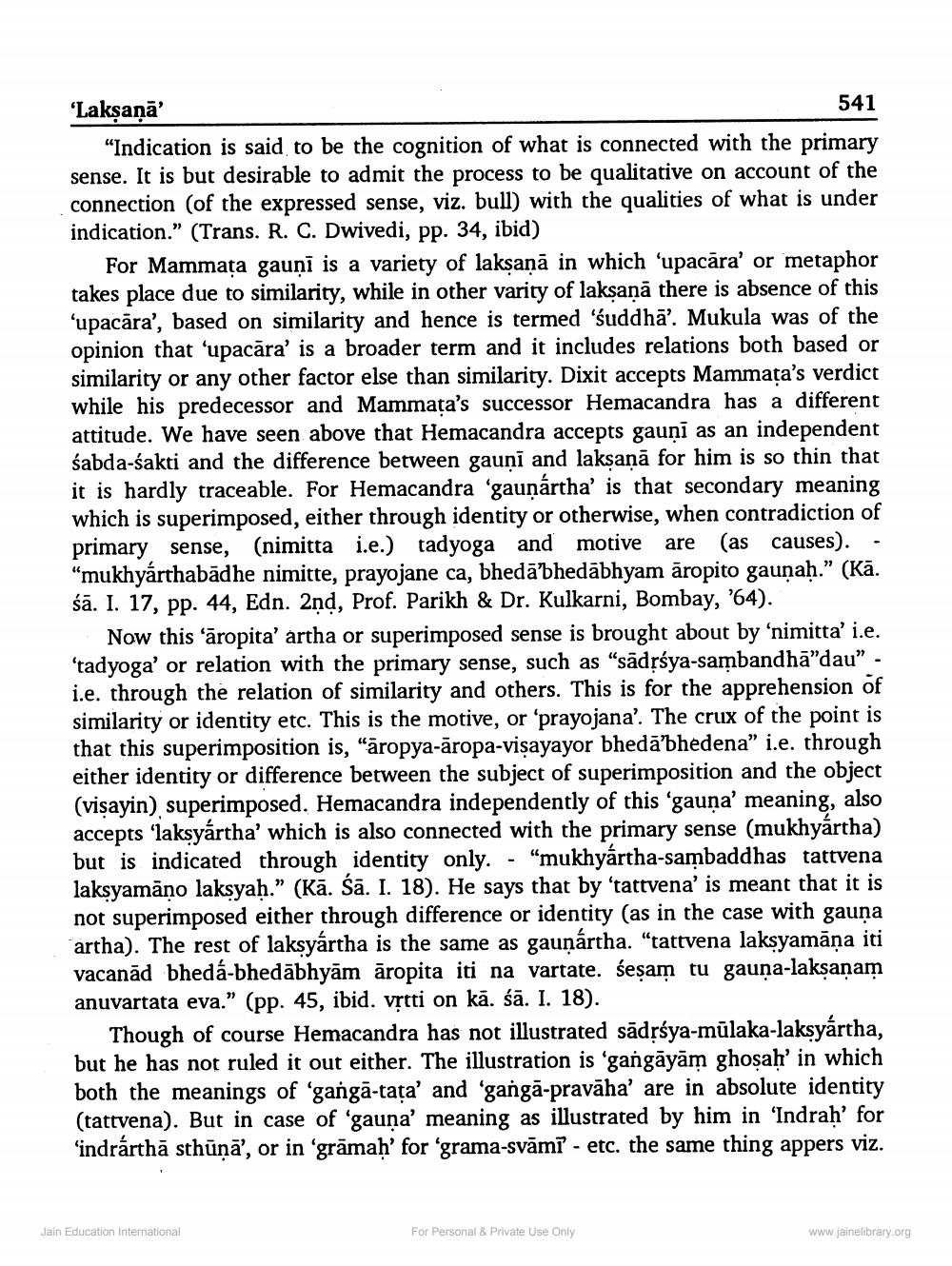________________
'Laksaņā'
541 "Indication is said to be the cognition of what is connected with the primary sense. It is but desirable to admit the process to be qualitative on account of the connection (of the expressed sense, viz. bull) with the qualities of what is under indication.” (Trans. R. C. Dwivedi, pp. 34, ibid)
For Mammata gauni is a variety of laksan, in which 'upacara' or metaphor takes place due to similarity, while in other varity of laksanā there is absence of this 'upacāra', based on similarity and hence is termed 'suddhā'. Mukula was of the opinion that 'upacara' is a broader term and it includes relations both based or similarity or any other factor else than similarity. Dixit accepts Mammata's verdict while his predecessor and Mammata's successor Hemacandra has a different attitude. We have seen above that Hemacandra accepts gauni as an independent śabda-sakti and the difference between gauni and laksanā for him is so thin that it is hardly traceable. For Hemacandra 'gauņártha' is that secondary meaning which is superimposed, either through identity or otherwise, when contradiction of primary sense, (nimitta i.e.) tadyoga and motive are (as causes). - "mukhyarthabādhe nimitte, prayojane ca, bhedā'bhedābhyam āropito gaunah.” (Kā. śā. I. 17, pp. 44, Edn. 2nd, Prof. Parikh & Dr. Kulkarni, Bombay, '64).
Now this ‘āropita' artha or superimposed sense is brought about by ‘nimitta' i.e. 'tadyoga' or relation with the primary sense, such as “sādrsya-samband i.e. through the relation of similarity and others. This is for the apprehension of similarity or identity etc. This is the motive, or 'prayojana'. The crux of the point is that this superimposition is, "āropya-āropa-visayayor bhedā'bhedena” i.e. through either identity or difference between the subject of superimposition and the object (vişayin) superimposed. Hemacandra independently of this 'gauna' meaning, also accepts 'laksyārtha' which is also connected with the primary sense (mukhyārtha) but is indicated through identity only. - “mukhyártha-sambaddhas tattvena laksyamāno laksyah." (Kā. Sā. I. 18). He says that by 'tattvena' is meant that it is not superimposed either through difference or identity (as in the case with gauņa artha). The rest of laksyártha is the same as gaunártha. "tattvena laksyamāna iti vacanād bhedá-bhedābhyām āropita iti na vartate. sesam tu gauņa-lakṣaṇam anuvartata eva.” (pp. 45, ibid. vrtti on kā. śā. I. 18).
Though of course Hemacandra has not illustrated sādrśya-mülaka-laksyártha, but he has not ruled it out either. The illustration is 'gangāyām ghosah' in which both the meanings of gangā-tata' and 'gangā-pravāha' are in absolute identity (tattvena). But in case of 'gauna' meaning as illustrated by him in 'Indrah' for 'indrárthā sthūņā, or in 'grāmaḥ' for 'grama-svāmī - etc. the same thing appers viz.
Jain Education International
For Personal & Private Use Only
www.jainelibrary.org




